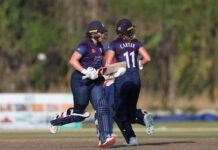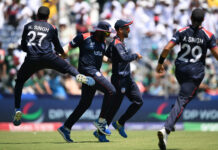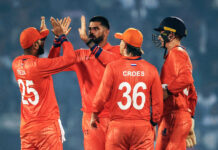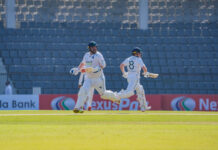With winter winding down and national events on the horizon, eager cricketers look for opportunities to improve their game across the country. USA Cricket and American Cricket Enterprises work to bring opportunities to bolster the national teams, with USA Cricket successfully conducting zonal trials, and Minor League Cricket managing to complete an abbreviated season of exhibition games late in the summer of 2020. As part of the effort to improve high performance opportunities for players in the U19 range, Major League Cricket (MLC) held their inaugural Elite Talent Development camp in Houston, Texas this week.
47 top youth players from around the country traveled to the Prairie View Cricket Complex for instruction from MLC coaching staff including Corey Anderson, Dane Piedt, Corné Dry, and Willem Ludick. Several of USA Cricket’s key coaching staff were also invited to attend, with USA Men’s Cricket Head Coach J Arunkumar, USA U19 Men’s Head Coach Kevin Darlington, and USA Cricket Physical Performance Manager Burt Cockley all on hand in Texas.
The occasion was also an opportunity for national coaches to assess young talent in the pipeline.
‘In that environment, it’s just a no-brainer that our Men’s National Youth Coach Kevin Darlington be there,’ USA Cricket Operations Director, Richard Done told Emerging Cricket.
‘And, given the opportunity for the Men’s National Coach then to meet with others in the area outside of the camp, it was just practical and obvious that our coaches should be involved. We’ll be getting our Men’s and Women’s coaching teams out around the grounds, academies and training camps where it’s possible to do so more and more as things open up across the USA.’
The camp featured two training groups. The first group, composed mostly of 17 and 18 year olds, ran from Wednesday through Saturday. The second group, composed mostly of 15 and 16-year-olds, ran from Saturday through Tuesday. With the first group, specialised training and classroom learning commenced for the first few days, followed by a 50 overs per side game against senior MiLC level competition, and a head to head T20 between two teams of campers.
“It’s always nice to get invited to these sort of camps for high intensity and training,” USA U19 all rounder Ali Sheik told Emerging Cricket. “The coaches also helped us a lot. They helped us develop as cricketers and gave us information on how to develop and perform on the highest level.”
The 18-year-old left-arm orthodox bowling, left-handed batting all rounder from Dallas has built a reputation for himself as an aggressive batsman in recent times, smashing six sixes in an over last year in a club game, and putting out solid all round production in the 2020 MiLC Exhibition for the first place Irving Mustangs. Ali was one of the standout performers during the week.
“Some of the stuff they said, like being consistent… like focus on my stock ball instead of a lot of variations. Keep one line and length, which is like good length, and just make the batsman work for everything and not give him anything loose, and just focus on consistency.”
Sanjay Krishnamurthi traveled from California’s Bay Area to the camp, but that doesn’t even begin to tell the story of his journey. Possibly Minor League Cricket’s most impressive performer in 2020 considering his age, Sanjay could just as easily be sharpening his skills in Bangalore.
Born in Arizona, Sanjay moved to Bangalore with his family at age eight in 2011, just as he developed a passion for cricket. Sanjay quickly became a student of the game. Already friends with USA U19 bowler Raj Vyas when Raj took 7 wickets against Cayman Islands, it was then that Sanjay started to investigate avenues for entry into the USA U19 team. In early 2020, Sanjay, by then a member of Bangalore’s U16 state team having developed in J Arunkumar’s academy, traveled with some friends to attend a two day camp with then-USA Cricket head Coach Jimmy Pamment during USA’s warmup tour in India ahead of their trip to Nepal.
In March of 2020, Sanjay traveled with his family as one of 26 players, along with Ali Sheikh, invited to USA Cricket’s men’s trials. Not long after the trials, while visiting his grandparents, Sanjay’s family found themselves stuck in the states due to Covid. After four months, Sanjay’s father found employment in San Francisco, the family moved, and Sanjay began training with Rusty Theron and Josh Dascombe.
‘I’d say that the training schedule is pretty comprehensive here in the Bay Area with coaches that we have,’ Sanjay told Emerging Cricket.
‘The only thing that I miss is still getting consistent practice on turf wickets. They started having weekend games on turf, so that’s good, but during the week it’s indoor practice, especially during the winter.’
After his first American winter since taking up cricket, Sanjay was looking forward to several days on turf in Houston.
‘It was quite a tiring week, actually, we had a good amount of work every day. Working with Dane (Piedt) was a really nice experience. He was funny, nice, it was just comfortable talking to him. We had turf practice on all the days, and it was great to work with a panel of coaches as experienced as we had there, with everyone playing at least first class cricket.’
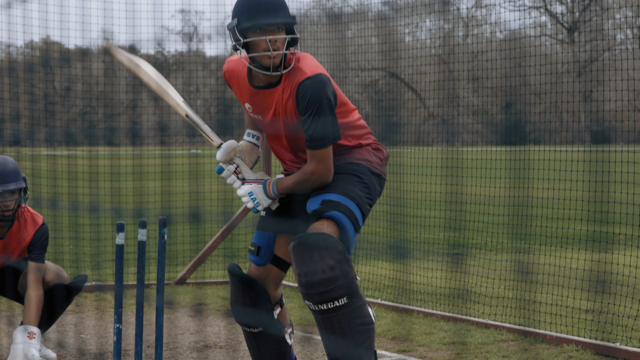
Former South African Test bowler Dane Piedt worked predominantly with the spinners during the camp.
‘It was a beautifully run camp, in my opinion. The plan was to obviously have a look the first couple of days at the players we’re working with, and I was pleasantly surprised coming from a cricket playing nation and walking into an environment where I didn’t know any of the kids, and eventually at the end of the camp knowing each and every kid and the ability they bring to the table’
‘I’m so, so thrilled about the amount of leg break spinners the United States have in Adam Khan, Adi Gupta,’ Piedt continued.
‘It’s also exciting when you get the more experienced cricketers like Sanjay and Ali Sheikh. So I basically worked with them, tried to put them in an intense environment where they have net sessions that have a consequence, so sort of setting targets, and bowling to the targets in power plays, setting fields, because the game awareness in the States is obviously not as high as back in South Africa. It was important to try and learn from them on what they feel the surface is going to do, and set fields accordingly. Having conversations like that is basically opening their minds to growing and evolving in the game.’
‘I was fortunate to see them in a sort of environment where they’re netting, and training, and sort of in a match environment. It’s really exciting to see the guys grow over the past few days, and they definitely, definitely have a bright future in the game.’
Throughout the week, the challenges on the turf wickets changed. Early on, the pitch was softer, a bit damp, and turning for the spinners. As the weekend progressed, the surface settled down and provided more for the batters. Challenges presented by grass wickets are a big part of the education, and part of the lure for the High Performance camp.
‘Sahil (Kancherla), from the Seattle region, it was the first time he had ever played on turf, and he’s a great player. And that for me is mind blowing!’
Piedt moved to the United States back in October, settling in Gaithersburg, a Maryland suburb of Washington, DC. There, he’s been coaching in local academies and working on his own game.
‘It’s been unbelievable, to be honest. It’s been seamless,’ Piedt said of his transition to the United States.
‘I’m really surprised at the number of facilities and indoor facilities that the United States have.’
Corey Anderson primarily worked with the batters. Having represented New Zealand in 93 internationals, and played 30 matches in the IPL, Anderson brings extensive high pressure experience to the camp.
Anderson is quite fond of the United States, and relocating closer to his wife’s family in Dallas has always been in the cards.
‘It was sort of an end goal, but obviously, the last twelve months have kind of flipped it around to make our life a little easier being here,’ Anderson admits.
‘Corey (Anderson) and David White were with the batters, and we were talking about how to go about different match scenarios, even stuff like how a batsman who’s yet to go in should use the time, how intently they should be in the game,’ Sanjay said.
‘He was explaining you don’t want to use too much mental energy when you’re waiting to bat, but you still don’t want to be out of the game and not knowing the situation when you go in. He described his experience of being in a World Cup semifinal and dealing with pressure.’
Anderson explained to Emerging Cricket, ‘these were the kinds of things that were really important to Major League Cricket as well. It wasn’t just teaching them about cricket, you’re not trying to teach them to be people, but you’re trying to get them to understand that there’s a massive human element of playing sport. You don’t just turn into a robot and cricket becomes everything in the world and there’s nothing else going on.’

‘I think the good thing is, the players and coaches that are involved are at a point in their lives, and in their careers, where they understand there’s two sides of it. You’ve got to enjoy your life, you’ve got to live life, and there’s also the fun side, which you get to play cricket, you get to play sport for a living. Yes, at the moment you’re probably living and breathing cricket, and this is what your focus is, but you’ve also got friends. Play with them, enjoy it. Play some other sports if there’s something you’re able to play. If you’re at school and you’re playing football or baseball, just enjoy it and understand what it is. You don’t have to be like ‘no, I play cricket, I’m not going to go do those things.’
The first group split up into two teams: MLC Reds, coached by Corey Anderson, and MLC Greens, coached by Dane Piedt. On the first day of games, the teams each played against senior players in a 50 overs aside game.
Team Green faced ACAC STL Americans, featuring former USA U19 Captain Joshua Kind and Men’s National Training Group invitee Luke Schofield. ACAC won the toss and chose to bat, scoring 139 on a slow wicket. Ali Sheikh, captaining Team Green, took 4 wickets in his 10 overs for 25 runs. East Bay Blazers’ Dev Thadani and South Zone Men’s Youth member Adam Khan added two wickets each. Atlanta Param Veer’s Heer Patel and New Jersey youngster Anirudh Immanuel added wickets to help Team Green take all ten in 42.4 overs.
MLC Greens found themselves behind early in the chase, losing two wickets in the first two overs for five runs. Top scorer and DC Hawks’ batsman Ritwik Behera (66 runs) and Sahil Kancherla steadied the ship with a 69 run partnership. Ali Sheik (29 from 26 balls) and Morrisville Cardinals’ Rohan Phadke partnered for the final 19 runs, carrying their bats with the Greens victorious in 27 overs.
MLC Reds faced off against Minor League Cricket’s Houston Hurricanes, and won the toss choosing to bat first. Silicon Valley Strikers’ Rahul Jariwala and Irving Mustangs’ Rehman Dar got the Reds off to a great start, partnering for 82 runs before Jariwala was bowled by Abdul Jabbar for 41 in the 15th over. Dar fell three overs later to former USA off-spinner Usman Rafiq for 38, with Team Red at 2/92. Captain Sanjay Krishnamurthi and New Jersey Stallions’ Saiteja Mukkamalla partnered for 41 more, before Sanjay was bowled by right arm quick Safiullah Faheem. Mukkamalla would go on to top score with 69 runs not out, but Team Red lost five wickets from the 37th over until they were all out in the 48th for 240 runs.
Houston would chase down the total in 47.1 overs, losing eight wickets along the way. Rohan Posinapally and Sanjay Krishnamurthi each took two wickets for Team Red, and Aditya Gupta did big damage, taking three wickets for 36 runs in nine overs. Aditya uprooted three in-form batters in the innings, stopping Shams Arefeen at 60, Shushant Modani at 48, and bowling MiLC Team Turf’s Prajith Mudi for 53.
The next day, MLC Reds and MLC Greens went head to head in a T20. The competitive spirit was palpable. ‘It was very competitive. It was competing for bragging rights of which team in the camp was better,’ Sanjay said. MLC Reds batted first, and Rehman Dar kept up his hot streak, scoring 65 runs from 55 balls. Sanjay added a blistering 42 from 26, with Skanda Rohit Sharma (17 from 12) and Morrisville Cardinals’ Abhiram Bolisetty partnering for 21 in the final two overs to boost the Reds to 147/4 in 20.
South Zone Youth leggie Adam Khan (4 overs, 25 runs, 1 wicket) and Irving Mustangs’ left arm pacer Soorya Selvakumar (4 overs, 28 runs) bowled their full quota efficiently, while Heer Patel (3 overs, 31 runs, 1 wicket), Ali Sheikh (3 overs, 20 runs) and Anirudh Immanuel (3 overs, 22 runs, 1 wicket) filled out the bowling for the Greens. Wicket Keeper and East Bay Blazer Shamith Pasula contributed with a catch, a stumping, and partnered with Behera for the runout wicket of Sanjay, cutting short the Reds captain’s destructive innings.
A few extras from Reds bowlers and a couple boundaries from Ritwik Behera had the Greens starting well, until West Zone Youth’s Rohan Posanipally bowled fellow West Zoner Aditya Srinivas for a duck, four balls into the second over. After a tidy 3rd over from Bolisetty, Posanipally took his second wicket in the fourth, and Bolisetty struck in the fifth, and Team Green ended the powerplay 33/3.
After South Zone leggy Aditya Gupta got Behera out LBW in the eighth over, Team Green found themselves in a 4/41 hole, needing 106 from 73 balls to win. From there, it was all Ali Sheikh (83 from 47) and Shamith Pasula (23 from 28), as the partnership added 109 without loss to win the game with five balls to spare.
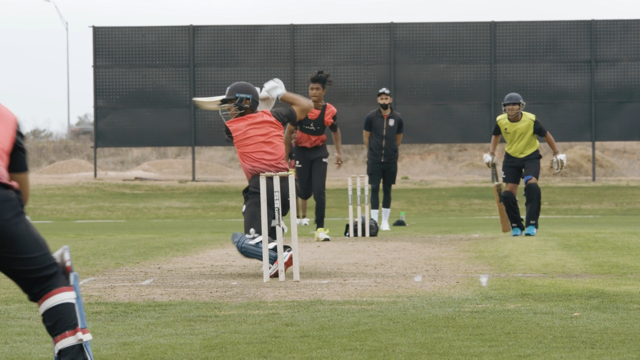
‘Unfortunately, we had the game under control until the 19th over,’ captain Sanjay remarked on the comeback. ‘(Ali Sheikh) was dropped three times, pretty regulation catches. And they were by some of the best fielders on our team too. In that (19th) over, he was sending them over the boundary line.’
In the 19th over, with the Greens needing 30 runs to win, Ali Sheikh expressed the kind of explosiveness he’s come to be known for, scoring 28 runs off of the first five deliveries: six, six, six, four, six. Needing only two to win in the 20th, Shamith scored four on the first ball to end the game.
‘My focus was to end the camp with a win. I knew that if I took the game deep and played sensibly I could take my team home,’ Ali said. ‘Luckily for me, I was seeing the ball well and connected them well. It is always a good feeling to score big runs in front of national coaching staff, and it was honestly a great end to camp for me.’
The campers now turn their attention to Nationals in April, likely followed by youth training camps which will determine the U19 team that will host the U19 Americas World Cup Qualifiers in August against Canada, Argentina and Bermuda.
‘Obviously with the nationals coming up in Houston at the start of April, that will be really exciting to see the guys that we had in attendance going off to that competition and see how they go,’ Corey Anderson said. ‘And hopefully there’s some other players there that aren’t involved in these (MLC) camps and they can be unearthed, and we can hopefully get them into an environment as well to be able to share our thoughts, and they can take that on as well.’
For now, the big goal for Sanjay and the elite campers is to represent the USA at the U19 level. ‘Since the day that I learned what the rules, the pathway is to qualifying for the World Cup, before thinking about the Minor League, or the Men’s team, or anything like that, my goal was always making the Under 19 World Cup, and showing people at the world stage that USA is here to compete.’
‘The guys kept speaking all week about ‘Canada, Canada, Canada,’
Dane Piedt said of the focus amongst the group. ‘We kept driving it into their head that it’s a process-driven thing. You can’t put out the fact that you need to beat Canada, because you still have to compete against Bermuda and Argentina, it’s all about the process. Obviously the goal at the end of the day is to qualify for the World Cup, but how are we going to get there? What are we going to do? How are we going to communicate? How are we going to respect each other?’
Corey Anderson echoes the process-driven emphasis. ‘I think the most important part is if we can teach the kids the disciplines around being professional, and the idea of what that involves, they can take some of those things back to their own cities and back to their own ecosystems and they can be self sufficient. In a country that’s so large, with not as many facilities as what cricket would like to have, not as many coaches, being self sufficient, regardless of what country you’re in, is probably the most important part of being a professional athlete.’
You’re reading Emerging Cricket — brought to you by a passionate group of volunteers with a vision for cricket to be a truly global sport, and a mission to inspire passion to grow the game.
Be sure to check out our homepage for all the latest news, please subscribe for regular updates, and follow EC on Twitter, Facebook, LinkedIn and YouTube.
Don’t know where to start? Check out our features list, country profiles, and subscribe to our podcast.
Support us from US$2 a month — and get exclusive benefits, by becoming an EC Patron.



